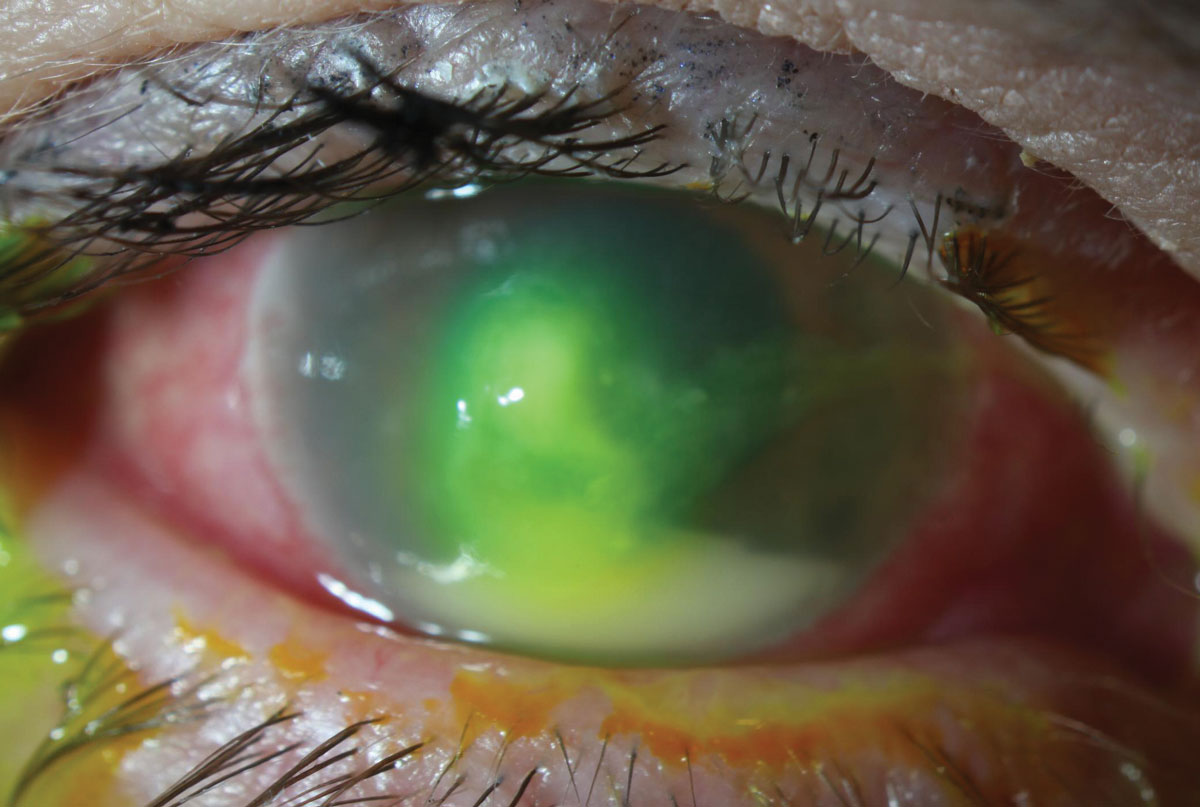 |
Q:
I recently heard a lecture about the different organisms that can cause infection in contact lens wearers. The lecturer made a point of separating these organisms into two different categories: environmental organisms and endogenous organisms. What are some examples of each and how do the two groups of organisms differ from each other?
A:
Organisms derived from either environmental or endogenous sources are similar in that they can all cause microbial keratitis (MK) in contact lens wearers, according to Fiona Stapleton, PhD. But they differ in their origins.
Environmental organisms exist in our external surroundings and are usually not part of the normal human microbiota. Examples of this class of organisms that cause MK include gram-negative bacteria, such as Pseudomonas aeruginosa and Serratia marcescens, and other types of organisms, such as filamentous fungi like Fusarium spp. and Aspergillus spp. and protozoa like Acanthamoeba spp., she notes. Dr. Stapleton adds that these organisms are more likely to be associated with MK in warmer or more tropical climates.1 She lists water, soil, vegetation, dust and airborne particles as environmental sources of organisms.
Dr. Stapleton notes that endogenous organisms, on the other hand, include those derived from the skin, such as coagulase-negative Staphylococci and Staphlococcus aureus, in the upper respiratory tract, such as Streptococcus pneumoniae and Streptococcus viridans, and in the gastrointestinal tract, such as Escherichia coli and Klebsiella spp.
 |
| Pseudomonas aeruginosa is one of the leading causes of contact lens–related MK. Photo: Aaron Bronner, OD. Click image to enlarge. |
Breeding Grounds
Contact lenses and ocular surfaces interact with these organisms in one of two ways, according to Dr. Stapleton, either through direct contact (e.g., showering in lenses) or indirect contact (e.g., handling of lenses).
Many studies agree that, depending on the geographic area, the majority (60%) of contact lens-related MK cases are caused by Pseudomonas aeruginosa and that environmental organisms make up about 75% of all culture-proven contact lens-related infections.1-4 In daily disposable contact lens wearers with MK, however, a study that Dr. Stapleton led found that significantly fewer infections were caused by environmental organisms.5 Dr. Stapleton suggests that this could be due to the lack of a storage case, which she adds may act as a vector for certain organisms.
Ward Off the Threat
Dr. Stapleton stresses that the type of causative organism has a major impact on the outcome of the disease, including the likelihood of vision loss, subsequent ocular surgery and the duration and cost of treatment.6 MK caused by environmental organisms tends to be more severe and vision-threatening than that caused by endogenous organisms, she says.1,6
Due to the high prevalence of contact lens-related MK cases caused by Pseudomonas aeruginosa, Dr. Stapleton notes that antibiotic treatment should have appropriate sensitivity in gram-negative bacteria. She recommends switching contact lens wearers to daily disposables to reduce the risk of severe disease in the first place. She also suggests informing contact lens users who live in or travel to warm or more tropical climates that they are more exposed to MK and educating them on proper precautions.
Corneal Scrape Results For Daily Disposable Wearers and Other Soft and Silicone Hydrogel Lens Wearers From Three Geographic Sites5 | ||||
| Scrape Result | Daily Disposable Wearers (n=55) | Non-Daily Disposable Soft and SiHy Wearers (n=200) | ||
| Culture-negative | 35 | 64% | 99 | 50% |
| Gram-positive bacteria* | 9 | 16% | 27 | 14% |
Staphylococcus aureus | 0 | 0% | 4 | 2% |
Coagulase-negative staphylococci/other staphylococci | 8 | 15% | 15 | 8% |
Streptococcus pneumoniae | 0 | 0% | 1 | 1% |
Streptococcus viridans | 1 | 2% | 1 | 1% |
Corynebacterium sp. | 0 | 0% | 3 | 2% |
Other gram-positive bacteria | 0 | 0% | 3 | 2% |
| Environmental organisms** | 11 | 20% | 74 | 37% |
| Gram-negative bacteria | 10 | 18% | 64 | 32% |
Pseudomonas aeruginosa or spp. | 9 | 6% | 53 | 27% |
Serratia marcescens | 1 | 2% | 8 | 4% |
Klebsiella oxygenate | 0 | 0% | 2 | 1% |
Other gram-negative bacteria | 0 | 0% | 1 | 1% |
| Nocardia spp. | 0 | 0% | 2 | 1% |
| Acanthamoeba | 0 | 0% | 5 | 3% |
| Fungi | 1 | 2% | 0 | 0% |
Fusarium dimerum | 1 | 2% | 0 | 0% |
Acremonium spp. | 0 | 0% | 1 | 1% |
Trichosporon mucoides | 0 | 0% | 1 | 1% |
Candida spp. | 0 | 0% | 1 | 1% |
| *Gram-positive bacteria included endogenous species and excluded Nocardia spp. **Environmental organisms included Gram-negative bacteria, fungi, Acanthamoeba spp. and Nocardia spp. | ||||
|
1. Stapleton F, Keay LJ, Sanfilippo PG, et al. Relationship between climate, disease severity, and causative organism for contact lens-associated microbial keratitis in Australia. Am J Ophthalmol. 2007;144(5):690-8. 2. Schein OD, Poggio EC. Ulcerative keratitis in contact lens wearers. Incidence and risk factors. Cornea. 1990;9(Suppl 1):S55-8, S62-3. 3. Galentine PG, Cohen EJ, Laibson PR, et al. Corneal ulcers associated with contact lens wear. Arch Ophthalmol. 1984;102(6):891-4. 4. Green M, Apel A, Stapleton F. Risk factors and causative organisms in microbial keratitis. Cornea. 2008;27(1):22-7. 5. Stapleton F, Naduvilath T, Keay L, et al. Risk factors and causative organisms in microbial keratitis in daily disposable contact lens wear. PLoS One. 2017;12(8):e0181343. 6. Keay L, Edwards K, Naduvilath T, et al. Factors affecting the morbidity of contact lens-related microbial keratitis: a population study. Invest Ophthalmol Vis Sci. 2006;47(10):4302-8. |

